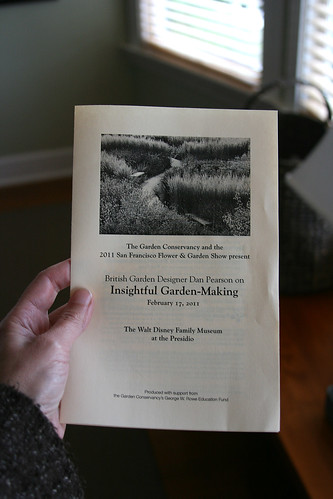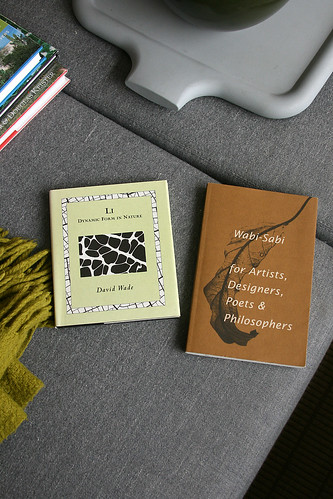I went to see Dan Pearson's lecture in San Francisco last night. Hosted by The Garden Conservancy and the San Francisco Flower and Garden Show, he spoke to us about some of the gardens he has created.
He lecture was very informative and inspirational and gosh, he seems like a great guy. It was clear in the way he spoke about designing his gardens that he puts his soul into them. Much thought is given to the "sense of place" and what effect the landscape needs to perform in each situation. Calm and soothing in the Maggie's Centre garden, a support organization for those with cancer; thought-provoking, wild and engaging in the Millennium Forest, a very large forest and garden devoted to raising awareness of ecology and conservation in Japan; to experimental, rejuvenating and treasured in his own garden in the middle of urban London.
It was wonderful to hear him speak in-depth about some of his projects as well as to see additional images of them. It was also very nice to hear him speak so fondly of the gardeners who take care of his particular projects. He seems to highly value those that continue to uphold the spirit of what he has created, since he out of necessity has to leave those creations at the doorsteps of others, so to speak.
He also raised the idea of randomness in plantings. He worked very hard to achieve a method of random planting at the garden of the Millennium Forest. And the results I have to say, were beautiful. Very wild and natural, well suited to the sense of the place. But it had me thinking, all my years of studying garden design I have focused on learning about repetition, pattern and creating a sense of order. Even in my loose planting schemes I try to create a rhythm that ties it all together. I've been taught that the eye needs a formula or pattern to follow or the eye can't rest and is just exhausted by the chaos. But his gardens had no conceivable pattern or rhythm, yet it was soothing and chaotic at the same time - fun chaotic, not maddening. So, how to achieve this randomness? In his design, the plant palettes seemed limited to a certain number of well-combined plants and the garden spaces were large. This technique is not going to work in a narrow border around someone's backyard. This type of planting is going to need a grand scale, a scale that can really invite nature in.
So does this randomness on the designer's part allow the subtle pattern in nature come to light? That idea brought to mind a couple of books which I dug out to re-read for future investigation- Li: Dynamic Form in Nature by David Wade and Wabi-Sabi for Artists, Designers, Poets and Philosophers by Leonard Koren. When I design, I'm going to give more thought to the idea of loosening up that grip of control and definition and see if I might lighten the designer's mark upon the garden. (Not that I'm designing Italianate parterres, or anything.)
And I hope to someday get the chance to travel to Japan to see the Millennium Forest. Indeed, I would love to spend an entire year there working in the gardens, watching them change through the seasons. But anyway, with no trips to Japan on the horizon, it was a lovely lecture and I'm glad I got to attend.
When he began speaking I was surprised at how deep his voice was. He seems so boyish, I didn't expect it to be so deep, but it now seems appropriate. I look forward to reading his next book Home Ground: Sanctuary in the City. Another of his books, Spirit: Garden Inspiration has become one of my favorite gardening books, discussed here. I'm hoping he is back for another lecture tour for his new book!



Thanks for your comments about the Dan Pearson talk. I just found out about it and regret that I didn't know in advance so that I could go. I heard him speak a few years ago and was really inspired by his thoughtful and natural approach to design.
ReplyDelete